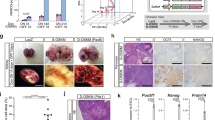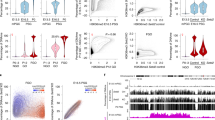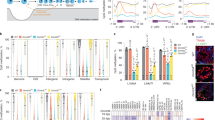Abstract
Genome-wide epigenetic modification plays a crucial role in regulating genome functions at critical stages of development. In particular, DNA methylation is known to be reprogrammed on a genome-wide level in germ cells and in preimplantation embryos, although it is relatively stable in somatic cells. In this reprogramming process, the genome becomes demethylated, and methylated de novo during later stages of development. Reprogramming of DNA methylation in male germ cells has not been fully investigated. Testicular germ cell tumors (TGCTs) possess a pluripotential nature and display protean histology from germ cells to embryonal and somatic cell differentiation. These properties make TGCT a unique model for studying germ cell development and gametogenesis in respect of DNA reprogramming. In order to obtain an insight into the epigenetic dynamics of TGCTs, we conducted a comprehensive analysis of differential methylated regions (DMRs) on H19 and IGF2 in TGCTs compared with testicular malignant lymphomas. In the present study, we show that methylation imprint at the promoter and CTCF-binding site upstream of H19 was completely erased in both seiminomatous and non-seminomatous TGCTs, whereas differential methylation was observed in testicular lymphomas. The erasure of methylation imprint was also observed in TGCTs with malignant transformation. We found biallelic unmethylation at the promoter and the CTCF-binding site upstream of H19 is required, but not sufficient for the biallelic expression of H19 in TGCTs. These data suggest that factors other than methylation contribute to transcriptional regulation of imprinted genes in TGCTs. The present data have shown that TGCTs carry distinctive epigenetic profiles at the core-imprinting domain of H19/IGF2 from other neoplasms of somatic cell origin. The data also suggest that both seminomatous and non-seminomatous TGCTs carry methylation profiles similar to fetal germ cells, but not adult germ cells, indicating the origin of TGCTs as fetal germ cells.
This is a preview of subscription content, access via your institution
Access options
Subscribe to this journal
Receive 50 print issues and online access
$259.00 per year
only $5.18 per issue
Buy this article
- Purchase on Springer Link
- Instant access to full article PDF
Prices may be subject to local taxes which are calculated during checkout






Similar content being viewed by others
Accession codes
References
Allen RC, Zoghbi HY, Moseley AB, Rosenblatt HM, Belmont JW . (1992). Am J Hum Genet 51: 1229–1239.
Barlow DP . (1993). Science 260: 309–310.
Bartolomei MS, Webber AL, Brunkow ME, Tilghman SM . (1993). Genes Dev 7: 1663–1673.
Bell AC, Felsenfeld G . (2000). Nature 405: 482–485.
Brandeis M, Kafri T, Ariel M, Chaillet JR, McCarrey J, Razin A et al. (1993). EMBO J 12: 3669–3677.
Clark SJ, Harrison J, Paul CL, Frommer M . (1994). Nucleic Acids Res 22: 2990–2997.
Cui H, Niemitz EL, Ravenel JD, Onyango P, Brandenburg SA, Lobanenkov VV et al. (2001). Cancer Res 61: 4947–4950.
Davis TL, Yang GJ, McCarrey JR, Bartolomei MS . (2000). Hum Mol Genet 9: 2885–2894.
Feinberg AP, Tycko B . (2004). Nat Rev Cancer 4: 143–153.
Ferguson-Smith AC, Sasaki H, Cattanach BM, Surani MA . (1993). Nature 362: 751–755.
Frevel MA, Sowerby SJ, Petersen GB, Reeve AE . (1999). J Biol Chem 274: 29331–29340.
Grant M, Zuccotti M, Monk M . (1992). Nat Genet 2: 161–166.
Hajkova P, Erhardt S, Lane N, Haaf T, El-Maarri O, Reik W et al. (2002). Mech Dev 117: 15–23.
Hark AT, Schoenherr CJ, Katz DJ, Ingram RS, Levorse JM, Tilghman SM . (2000). Nature 405: 486–489.
Holstein AF . (1993). Eur Urol 23 (Suppl 2): 9–18.
Huber R, Hansen RS, Strazzullo M, Pengue G, Mazzarella R, D'Urso M et al. (1999). Proc Natl Acad Sci USA 96: 616–621.
Jaenisch R . (1997). Trends Genet 13: 323–329.
Jinno Y, Sengoku K, Nakao M, Tamate K, Miyamoto T, Matsuzaka T et al. (1996). Hum Mol Genet 5: 1155–1161.
Jorgensen N, Rajpert-DeMeyts E, Graem N, Muller J, Giwercman A, Skakkebaek NE . (1995). Lab Invest 72: 223–231.
Kafri T, Ariel M, Brandeis M, Shemer R, Urven L, McCarrey J et al. (1992). Genes Dev 6: 705–714.
Kato Y, Rideout III WM, Hilton K, Barton SC, Tsunoda Y, Surani MA . (1999). Development 126: 1823–1832.
Kawakami T, Okamoto K, Ogawa O, Okada Y . (2004a). Lancet 363: 40–42.
Kawakami T, Okamoto K, Sugihara H, Hattori T, Reeve AE, Ogawa O et al. (2003). J Urol 169: 1546–1552.
Kawakami T, Zhang C, Taniguchi T, Kim CJ, Okada Y, Sugihara H et al. (2004b). Oncogene 23: 6163–6169.
Kerjean A, Dupont JM, Vasseur C, Le Tessier D, Cuisset L, Paldi A et al. (2000). Hum Mol Genet 9: 2183–2187.
Kirchgessner CU, Warren ST, Willard HF . (1995). J Med Genet 32: 925–929.
Klenova EM, Morse III HC, Ohlsson R, Lobanenkov VV . (2002). Semin Cancer Biol 12: 399–414.
Lee J, Inoue K, Ono R, Ogonuki N, Kohda T, Kaneko-Ishino T et al. (2002). Development 129: 1807–1817.
Li E . (2002). Nat Rev Genet 3: 662–673.
Looijenga LH, Stoop H, de Leeuw HP, de Gouveia Brazao CA, Gillis AJ, van Roozendaal KE et al. (2003). Cancer Res 63: 2244–2250.
Loukinov DI, Pugacheva E, Vatolin S, Pack SD, Moon H, Chernukhin I et al. (2002). Proc Natl Acad Sci USA 99: 6806–6811.
Moller H . (1989). J Natl Cancer Inst 81: 1668–1669.
Moulton T, Crenshaw T, Hao Y, Moosikasuwan J, Lin N, Dembitzer F et al. (1994). Nat Genet 7: 440–447.
Nakagawa H, Chadwick RB, Peltomaki P, Plass C, Nakamura Y, de La Chapelle A . (2001). Proc Natl Acad Sci USA 98: 591–596.
Nonomura N, Miki T, Nishimura K, Kanno N, Kojima Y, Okuyama A . (1997). J Urol 157: 1977–1979.
Ogawa O, Eccles MR, Szeto J, McNoe LA, Yun K, Maw MA et al. (1993). Nature 362: 749–751.
Okano M, Bell DW, Haber DA, Li E . (1999). Cell 99: 247–257.
Oosterhuis JW, Looijenga LH . (2005). Nat Rev Cancer 5: 210–222.
Rainier S, Johnson LA, Dobry CJ, Ping AJ, Grundy PE, Feinberg AP . (1993). Nature 362: 747–749.
Rajpert-De Meyts E, Hanstein R, Jorgensen N, Graem N, Vogt PH, Skakkebaek NE . (2004). Hum Reprod 19: 1338–1344.
Reik W, Dean W, Walter J . (2001). Science 293: 1089–1093.
Ross JA, Schmidt PT, Perentesis JP, Davies SM . (1999). Cancer 85: 1389–1394.
Shiota K, Yanagimachi R . (2002). Differentiation 69: 162–166.
Skakkebaek NE . (1972). Lancet 2: 516–517.
Skakkebaek NE, Berthelsen JG, Giwercman A, Muller J . (1987). Int J Androl 10: 19–28.
Smiraglia DJ, Szymanska J, Kraggerud SM, Lothe RA, Peltomaki P, Plass C . (2002). Oncogene 21: 3909–3916.
Steenman MJ, Rainier S, Dobry CJ, Grundy P, Horon IL, Feinberg AP . (1994). Nat Genet 7: 433–439.
Sullivan MJ, Taniguchi T, Jhee A, Kerr N, Reeve AE . (1999). Oncogene 18: 7527–7534.
Szabo PE, Mann JR . (1995a). Genes Dev 9: 3097–3108.
Szabo PE, Mann JR . (1995b). Genes Dev 9: 1857–1868.
Tada T, Tada M, Hilton K, Barton SC, Sado T, Takagi N et al. (1998). Dev Genes Evol 207: 551–561.
Takai D, Gonzales FA, Tsai YC, Thayer MJ, Jones PA . (2001). Hum Mol Genet 10: 2619–2626.
Taniguchi T, Sullivan MJ, Ogawa O, Reeve AE . (1995). Proc Natl Acad Sci USA 92: 2159–2163.
Thorvaldsen JL, Duran KL, Bartolomei MS . (1998). Genes Dev 12: 3693–3702.
Ulaner GA, Yang Y, Hu JF, Li T, Vu TH, Hoffman AR . (2003). Endocrinology 144: 4420–4426.
Ulbright TM . (1993). Am J Surg Pathol 17: 1075–1091.
van Gurp RJ, Oosterhuis JW, Kalscheuer V, Mariman EC, Looijenga LH . (1994). J Natl Cancer Inst 86: 1070–1075.
Verkerk AJ, Ariel I, Dekker MC, Schneider T, van Gurp RJ, de Groot N et al. (1997). Oncogene 14: 95–107.
Villar AJ, Eddy EM, Pedersen RA . (1995). Dev Biol 172: 264–271.
Vu TH, Li T, Nguyen D, Nguyen BT, Yao XM, Hu JF et al. (2000). Genomics 64: 132–143.
Yun K, Soejima H, Merrie AE, McCall JL, Reeve AE . (1999). J Pathol 187: 518–522.
Zhang C, Kawakami T, Okada Y, Okamoto K . (2005). Genes Chromosomes Cancer 43: 104–112.
Zhang Y, Shields T, Crenshaw T, Hao Y, Moulton T, Tycko B . (1993). Am J Hum Genet 53: 113–124.
Acknowledgements
This work was supported by Grants-in-aid 16390462 and 17390438 from the Ministry of Education, Culture, Sports, Science and Technology, Japan and Research Grant from Takeda Science Foundation and Research Grant for the Princess Takamatsu Cancer Research Fund (04-23603).
Author information
Authors and Affiliations
Corresponding author
Rights and permissions
About this article
Cite this article
Kawakami, T., Zhang, C., Okada, Y. et al. Erasure of methylation imprint at the promoter and CTCF-binding site upstream of H19 in human testicular germ cell tumors of adolescents indicate their fetal germ cell origin. Oncogene 25, 3225–3236 (2006). https://doi.org/10.1038/sj.onc.1209362
Received:
Revised:
Accepted:
Published:
Issue Date:
DOI: https://doi.org/10.1038/sj.onc.1209362
Keywords
This article is cited by
-
Analysis of the Paternally-Imprinted DLK1–MEG3 and IGF2–H19 Tandem Gene Loci in NT2 Embryonal Carcinoma Cells Identifies DLK1 as a Potential Therapeutic Target
Stem Cell Reviews and Reports (2018)
-
DNA methylation analysis reveals distinct methylation signatures in pediatric germ cell tumors
BMC Cancer (2013)
-
Testicular germ cell tumor susceptibility genes from the consomic 129.MOLF-Chr19 mouse strain
Mammalian Genome (2007)



